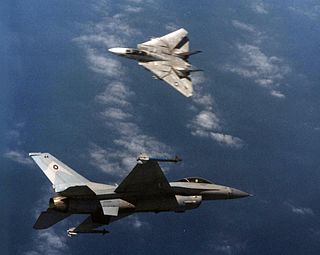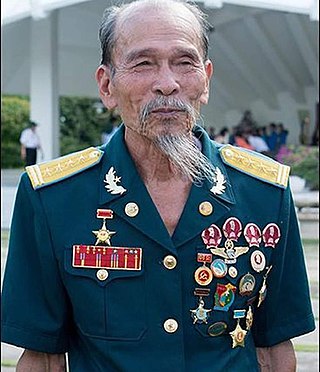This article needs additional citations for verification .(May 2021) |
During the Vietnam War, the U.S. confirmed 206 aircraft lost to North Vietnamese surface-to-air missiles.
However, some of the U.S. aircraft "crashed in flight accidents", in fact, were lost to S-75 missiles. When landing at an airfield in Thailand, one B-52 was heavily damaged by a SAM, rolled off the runway and exploded on mines that had been installed around the airfield for protection from enemy attacks; only one crewman survived. Subsequently, this B-52 was counted as "crashed in flight accidents".[ citation needed ] According to Dana Drenkowski and Lester W. Grau, the number of U.S. aircraft lost, confirmed by the U.S. is uncorroborated since the U.S. figures are also suspect. If a plane was badly damaged, but managed to land, the USAF did not normally count it as an aerial combat loss, even if it was too damaged to fly again. [1]
During the Vietnam war, the Soviet Union deployed missile operators along with 95 S-75 systems and 7,658 missiles to the North Vietnamese. From 1965 thru 1967 Soviet missilemen downed nearly 50 U.S. attack or reconnaissance jet aircraft. [2] [3] 6,806 missiles were launched or removed because they were outdated (including 5,800 launches [4] ). In total, the U.S. lost 3,374 fixed wing aircraft in combat during the war; in both North and South Vietnam. According to the North Vietnamese, 31% were shot down by S-75 missiles (1,046 aircraft, or 6 missiles per one kill); 60% were shot down by anti-aircraft guns; and 9% were shot down by MiG fighters. The S-75 missile system significantly improved the effectiveness of North Vietnamese anti-aircraft artillery, which used data from S-75 radar stations [5]
The following is a list of 205 U.S. aircraft lost to surface-to-air missiles during the Vietnam War (confirmed by the U.S.)
| Year / aircraft / totals | SAM type | Altitude struck: low to high in feet |
|---|---|---|
| 1965 | ||
| F-4B, F-4C Phantom II (4) | SA-2 | 11,000 to 23,000 |
| F-8E Crusader (2) | SA-2 | 30,000 to 33,000 |
| F-105D Thunderchief (3) | SA-2 | 4,000 to 18,000 |
| A-4E Skyhawk (1) | SA-2 | 9,000 |
| A-6A Intruder (1) | SA-2 | 4,000 |
| RA-5C Vigilante (2) | SA-2 | 1,500 and 3,200 |
| Year total: 13 | ||
| 1966 | ||
| F-4B, F-4C Phantom II (8) | SA-2 | 4,000 to 25,000 |
| F-8E Crusader (2) | SA-2 | 6,000 and 12,000 |
| RF-101C Voodoo (3) | SA-2 | 7,000 (2 unknown) |
| F-105D, F-105F Thunderchief (5) | SA-2 | 6,000 to 16,000 |
| F-104C Starfighter (3) | SA-2 | 4,000 to 10,000 |
| A-1H Skyraider (2) | SA-2 | 1,000 and 7,500 |
| A-4C Skyhawk (8) | SA-2 | 4,000 to 12,000 (3 unknown) |
| RB-66C Destroyer (2) | SA-2 | 29,000 and 30,000 |
| EF-10B Skynight (1) | SA-2 | Unknown |
| RA-5C Vigilante (1) | SA-2 | 3,000 |
| Year total: 35 | ||
| 1967 | ||
| F-4B, F-4C, RF-4C, F-4D Phantom II (14) | SA-2 | 1,500 to 24,000 (1 unknown) |
| F-8C, F-8E Crusader (4) | SA-2 | 1,500 15,500 |
| RF-101C Voodoo (2) | SA-2 | 18,000 to 30,000 |
| F-105D, F-105F Thunderchief (15) | SA-2 | 6,000 to 19,000 (1 unknown) |
| A-4C, A-4F Skyhawk (21) | SA-2 | 1,200 to 17,000 (1 unknown) |
| A-6A Intruder (3) | SA-2 | 3,500 to 12,000 |
| A-7A Corsair II (1) | SA-2 | 15,000 |
| EB-66 Destroyer (1) | SA-2 | 30,000 |
| O-1 Bird Dog (1) | SA-2 | 8,000 |
| Year total: 62 | ||
| 1968 | ||
| F-4D, F-4J Phantom II (2) | SA-2 | 2,600 and 15,000 |
| F-8E Crusader (2) | SA-2 | 5,000 and 15,000 |
| F-105D, F-105F Thunderchief (2) | SA-2 | 8,000 and 12,000 |
| A-4C, A-4E Skyhawk (2) | SA-2 | 11,000 and 12,000 |
| A-6A, A-6B Intruder (3) | SA-2 | 5,000 and 15,000 (1 unknown) |
| A-7A Corsair II (1) | SA-2 | 10,000 |
| Year total: 12 | ||
| 1970 | ||
| F-105G Thunderchief (1) | SA-2 | unknown |
| Year total: 1 | ||
| 1971 | ||
| F-4B, F-4D, F-4E Phantom II (4) | SA-2 | 18,000 and 20,000 (2 unknown) |
| F-105G Thunderchief (1) | SA-2 | 18,000 |
| O-2 Skymaster (1) | SA-2 | 7,000 |
| A-6A Intruder (1) | SA-2 | 12,000 |
| Year total: 7 | ||
| 1972 | ||
| F-4D, F-4E, F-4J, RF-4C Phantom II (20) | SA-2 | 3,500 to 21,000 (5 unknown) |
| F-8J Crusader (1) | SA-2 | 11,000 |
| F-105G Thunderchief (4) | SA-2 | 11,000 and 19,000 (2 unknown) |
| A-1E, A-1H, A-1G Skyraider (3) | SA-7 | 3,500/5,500/6,500 |
| A-6A Intruder (1) | SA-2 | 13,000 |
| A-7A, A-7B, A-7C, A-7E Corsair II (13) | SA-2 | 1,000 to 19,000 (2 unknown) |
| TA-4F Skyhawk (1) | SA-2 | 4,500 |
| RA-5C Vigilante (1) | SA-2 | 3,000 |
| EB-66C Destroyer (1) | SA-2 | 24,000 |
| AC-130A Spectre (2) | SA-2/SA-7 | 8,500 (SA-7 unknown) |
| O-1 Bird Dog (2) | SA-7 | 4,000 (second SA-7 unknown) |
| O-2 Skymaster (2) | SA-2/SA-7 | Unknown |
| OV-10A Bronco (5) | SA-2/SA-7 | 5,000; unknown;5,000/SA-7 6,500 |
| (10) B-52D, (6) B-52G Stratofortress (16) | SA-2 | 25,000 to 38,500 |
| Year total: 72 | ||
| 1973 | ||
| B-52D Stratofortress(1) | SA-2 | Unknown |
| A-6A Intruder (1) | SA-2 | Unknown |
| OV-10A Bronco (1) | SA-7 | 6,000 |
| UH-1H (1) | SA-7 | 3,200 |
| Year total: 4 | ||
| War total: 206 |














